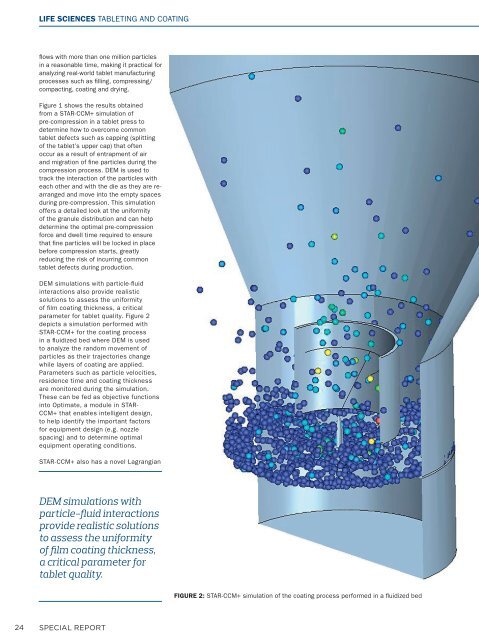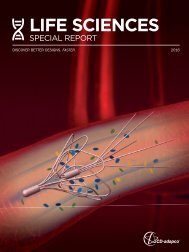Life Science Special Report December 2015
The Life Sciences Sector is experiencing an unprecedented change...
The Life Sciences Sector is experiencing an unprecedented change...
- No tags were found...
You also want an ePaper? Increase the reach of your titles
YUMPU automatically turns print PDFs into web optimized ePapers that Google loves.
LIFE SCIENCES TABLETING AND COATING<br />
flows with more than one million particles<br />
in a reasonable time, making it practical for<br />
analyzing real-world tablet manufacturing<br />
processes such as filling, compressing/<br />
compacting, coating and drying.<br />
Figure 1 shows the results obtained<br />
from a STAR-CCM+ simulation of<br />
pre-compression in a tablet press to<br />
determine how to overcome common<br />
tablet defects such as capping (splitting<br />
of the tablet’s upper cap) that often<br />
occur as a result of entrapment of air<br />
and migration of fine particles during the<br />
compression process. DEM is used to<br />
track the interaction of the particles with<br />
each other and with the die as they are rearranged<br />
and move into the empty spaces<br />
during pre-compression. This simulation<br />
offers a detailed look at the uniformity<br />
of the granule distribution and can help<br />
determine the optimal pre-compression<br />
force and dwell time required to ensure<br />
that fine particles will be locked in place<br />
before compression starts, greatly<br />
reducing the risk of incurring common<br />
tablet defects during production.<br />
DEM simulations with particle-fluid<br />
interactions also provide realistic<br />
solutions to assess the uniformity<br />
of film coating thickness, a critical<br />
parameter for tablet quality. Figure 2<br />
depicts a simulation performed with<br />
STAR-CCM+ for the coating process<br />
in a fluidized bed where DEM is used<br />
to analyze the random movement of<br />
particles as their trajectories change<br />
while layers of coating are applied.<br />
Parameters such as particle velocities,<br />
residence time and coating thickness<br />
are monitored during the simulation.<br />
These can be fed as objective functions<br />
into Optimate, a module in STAR-<br />
CCM+ that enables intelligent design,<br />
to help identify the important factors<br />
for equipment design (e.g. nozzle<br />
spacing) and to determine optimal<br />
equipment operating conditions.<br />
STAR-CCM+ also has a novel Lagrangian<br />
DEM simulations with<br />
particle-fluid interactions<br />
provide realistic solutions<br />
to assess the uniformity<br />
of film coating thickness,<br />
a critical parameter for<br />
tablet quality.<br />
FIGURE 2: STAR-CCM+ simulation of the coating process performed in a fluidized bed<br />
24 SPECIAL REPORT



